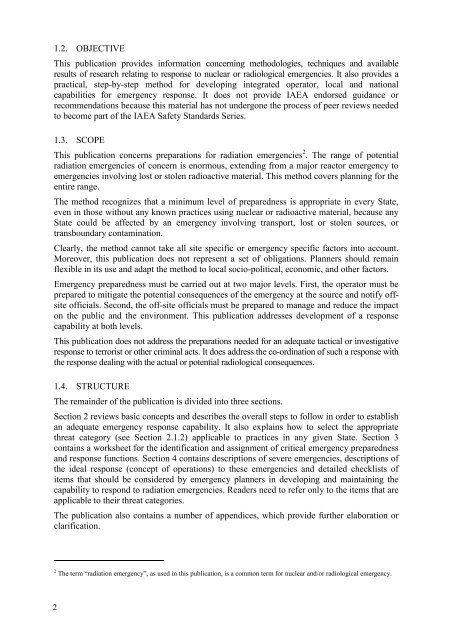epr-method (2003) - IAEA Publications - International Atomic Energy ...
epr-method (2003) - IAEA Publications - International Atomic Energy ...
epr-method (2003) - IAEA Publications - International Atomic Energy ...
You also want an ePaper? Increase the reach of your titles
YUMPU automatically turns print PDFs into web optimized ePapers that Google loves.
1.2. OBJECTIVE<br />
This publication provides information concerning <strong>method</strong>ologies, techniques and available<br />
results of research relating to response to nuclear or radiological emergencies. It also provides a<br />
practical, step-by-step <strong>method</strong> for developing integrated operator, local and national<br />
capabilities for emergency response. It does not provide <strong>IAEA</strong> endorsed guidance or<br />
recommendations because this material has not undergone the process of peer reviews needed<br />
to become part of the <strong>IAEA</strong> Safety Standards Series.<br />
1.3. SCOPE<br />
This publication concerns preparations for radiation emergencies 2 . The range of potential<br />
radiation emergencies of concern is enormous, extending from a major reactor emergency to<br />
emergencies involving lost or stolen radioactive material. This <strong>method</strong> covers planning for the<br />
entire range.<br />
The <strong>method</strong> recognizes that a minimum level of preparedness is appropriate in every State,<br />
even in those without any known practices using nuclear or radioactive material, because any<br />
State could be affected by an emergency involving transport, lost or stolen sources, or<br />
transboundary contamination.<br />
Clearly, the <strong>method</strong> cannot take all site specific or emergency specific factors into account.<br />
Moreover, this publication does not r<strong>epr</strong>esent a set of obligations. Planners should remain<br />
flexible in its use and adapt the <strong>method</strong> to local socio-political, economic, and other factors.<br />
Emergency preparedness must be carried out at two major levels. First, the operator must be<br />
prepared to mitigate the potential consequences of the emergency at the source and notify offsite<br />
officials. Second, the off-site officials must be prepared to manage and reduce the impact<br />
on the public and the environment. This publication addresses development of a response<br />
capability at both levels.<br />
This publication does not address the preparations needed for an adequate tactical or investigative<br />
response to terrorist or other criminal acts. It does address the co-ordination of such a response with<br />
the response dealing with the actual or potential radiological consequences.<br />
1.4. STRUCTURE<br />
The remainder of the publication is divided into three sections.<br />
Section 2 reviews basic concepts and describes the overall steps to follow in order to establish<br />
an adequate emergency response capability. It also explains how to select the appropriate<br />
threat category (see Section 2.1.2) applicable to practices in any given State. Section 3<br />
contains a worksheet for the identification and assignment of critical emergency preparedness<br />
and response functions. Section 4 contains descriptions of severe emergencies, descriptions of<br />
the ideal response (concept of operations) to these emergencies and detailed checklists of<br />
items that should be considered by emergency planners in developing and maintaining the<br />
capability to respond to radiation emergencies. Readers need to refer only to the items that are<br />
applicable to their threat categories.<br />
The publication also contains a number of appendices, which provide further elaboration or<br />
clarification.<br />
2 The term “radiation emergency”, as used in this publication, is a common term for nuclear and/or radiological emergency.<br />
2

















